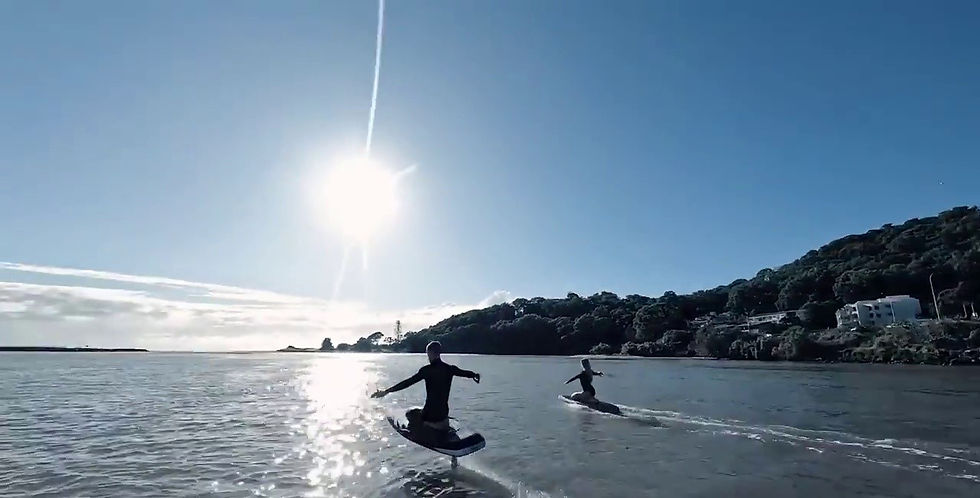How to learn efoil surfing with the right equipment and training
- makeyia
- Nov 29, 2024
- 4 min read
Learning efoil surfing can be an exciting and rewarding experience, combining the thrill of surfing with the power and ease of electric propulsion. However, it requires the right equipment and training to ensure safety and success. Here's a step-by-step guide to help you get started:

1. Understand the Basics of Efoil Surfing
An efoil (electric hydrofoil surfboard) uses an electric motor to propel a board with a hydrofoil beneath it, lifting you above the water’s surface at speed. The efoil can reach speeds up to 25 mph (40 km/h) and is often described as a combination of wakeboarding, surfing, and flying.
2. Choose the Right Equipment
Board Selection:
Beginner-Friendly Board: Look for an efoil board designed for beginners. These boards are typically larger, providing better stability as you learn to balance. Boards with a longer deck (around 5 to 6 feet) are often easier to control when you’re starting out.
Battery Capacity: The battery’s size affects how long you can ride. Larger batteries allow for more ride time but may be heavier. A medium-range battery (around 60-90 minutes of use) is ideal for beginners.
Hydrofoil Size: The size of the hydrofoil plays a significant role in your stability and ease of learning. A larger, more stable hydrofoil is ideal for beginners, as it requires less speed to lift you above the water.
Electric Motor: Beginners should choose an efoil with a lower-powered motor to allow easier control and a smoother learning experience. Around 2-3 kW is a good starting point.
Key Brands to Consider:
Lift Foils
Waydoo
Fliteboard
Radinn
These brands offer beginner-friendly options, but research reviews and customer feedback to choose the one that suits your needs.
3. Essential Safety Gear
Helmet: Always wear a helmet for protection, especially when you're learning and getting used to the speed and balance.
Wetsuit: A wetsuit helps keep you warm and also provides some additional protection. Choose a thickness suited for the water temperature where you’re surfing.
Life Vest: A foam life vest or impact vest can help with flotation and buoyancy in case you fall or tire out.
Leash: A leash ensures the board stays with you when you fall off, preventing it from drifting away and helping to quickly get back on.
4. Training and Lessons
Start with Professional Lessons: Taking lessons from a certified instructor is one of the best ways to quickly get the hang of efoiling. They can teach you the following key skills:
Balancing on the board: Learn how to stand properly, distribute your weight, and keep balance while on the efoil.
Handling the throttle: The efoil motor is controlled by a handheld remote. Learning how to gently accelerate and decelerate is crucial to maintaining control.
Water entry and take-off: Instructors will teach you how to safely enter the water, maintain stability, and achieve a controlled takeoff.
Hydrofoil control: Once you get on the board, the hydrofoil provides lift, and you’ll need to learn how to keep the foil above the water for optimal speed and stability.
Practice:
Start on a calm, flat water surface: Choose a calm day with minimal wind and flat water for your first sessions.
Begin in shallow waters: This way, you can easily stand up on the board and get comfortable before venturing into deeper areas.
Focus on the basics: Get used to riding without the hydrofoil lifting before you try to get the foil out of the water.
Get comfortable with speed: Start slow and gradually increase speed as you get more confident and skilled at balancing.
5. Gradual Progression
First Steps: Begin by learning how to control the throttle and glide around on the board. Get comfortable with balancing on the efoil before attempting to fly above the water.
Hydrofoil Lift: Once you’re stable at slower speeds, practice gradually increasing the throttle to lift the hydrofoil out of the water. The feeling of the foil lifting is quite different, as you’ll need to adjust your body position to maintain balance.
Turning and Maneuvering: After learning to control speed and lift, start practicing turning by shifting your body weight and learning how to maneuver the board effectively.
Advanced Techniques: As you become more confident, you can try tricks or riding in choppier conditions, but always keep safety in mind.
6. Maintenance and Care
Cleaning: After each ride, rinse your efoil with fresh water to prevent saltwater corrosion, especially on the motor, battery, and electrical components.
Battery Care: Keep the battery charged but avoid completely draining it before recharging. Proper battery maintenance extends its lifespan.
Storage: When not in use, store your board in a cool, dry place to ensure it remains in good condition.
7. Additional Tips for Success
Patience: Efoiling can be challenging at first, but with patience and practice, you will improve.
Proper Body Posture: Keep your body slightly bent at the knees, and always lean slightly forward when taking off. This helps with stability and ensures that the board doesn’t lose its lift.
Stay Safe: Always follow local regulations regarding efoiling. Stick to designated areas, avoid crowded spots, and be aware of your surroundings.
By following these steps and taking the time to learn, you can enjoy the excitement of efoil surfing while keeping yourself safe and comfortable.





Comments